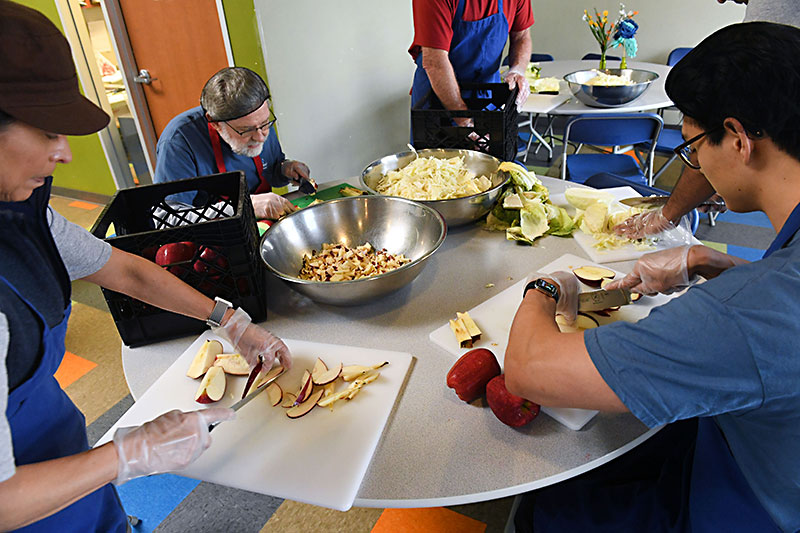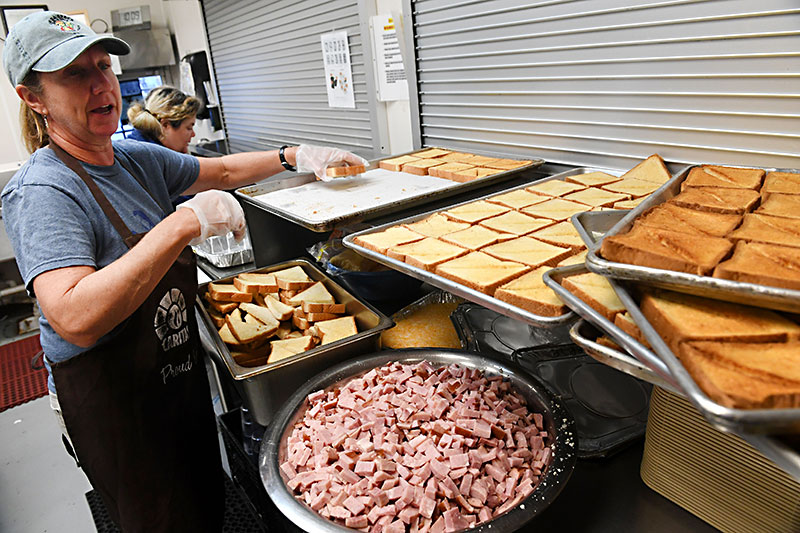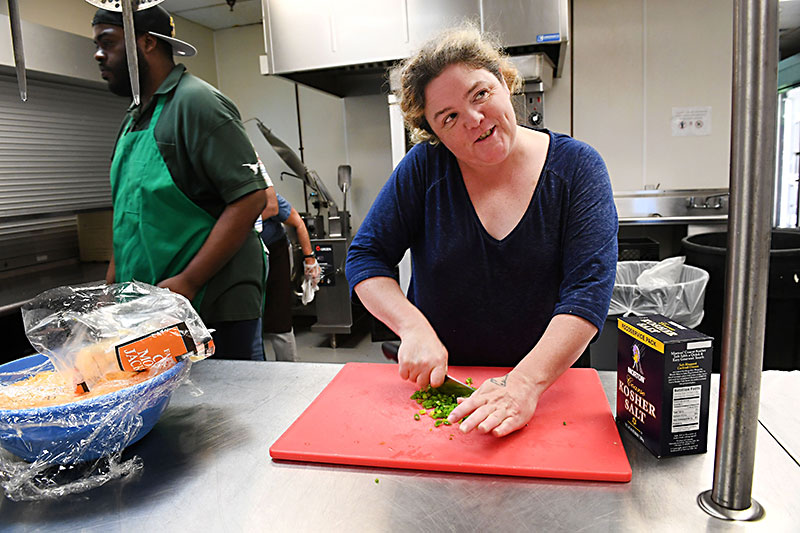How Austin Keeps Its Homeless Citizens Fed
“You want meals that feel like a hug"
By Dan Gentile, Fri., March 24, 2017
Two hulking turkeys with skin browned to a Thanksgiving crisp keep a team of volunteers occupied on a Wednesday afternoon in the Caritas Community Kitchen, the steaming-hot breast meat nearly melting plastic gloves as it's pulled for a turkey and white bean stew that will feed 350 people experiencing homelessness.
Chef Jen Mattson oversees the process, saving the turkey bones for stock. For five years Mattson ran northwest Arkansas' first food truck called Heirloom, which partnered with grocery stores to buy their unsold produce at a discount to hack together a full menu. The approach carries over to the Caritas kitchen, where she improvises a daily menu based on donations and a pantry of staples.
"My job is to make something as healthy and as tasty and as fresh as I possibly can. A lot of times if I have a plan in the morning, that will change. This weekend we got a bunch of green beans donated that have to be used, so that changes the planning. It's about knowing what the clientele will eat and how to make those adjustments on the fly," says Mattson.
Those experiencing homelessness in more remote parts of Austin have a harder time finding food, but Downtown a broad coalition of organizations offer food services to roughly 13,000 people a year, according to statistics from Austin Ending Community Homelessness Coalition (ECHO). Caritas' 350-plus daily clients typically receive a full five-course tray that includes salad, fruit, protein, vegetable, dessert, and milk. The diners range from the chronically homeless to working poor transitioning out of life on the streets and relying on community kitchens to stretch paychecks.
Adrian Sandoval is one such case; he eats at Caritas almost every day while on break from his construction job. The streets were his home for years, but he now finds temporary shelter through his church. He also happens to be vegan.
"I believe that diet plays a major role in our everyday life. There's truth to the saying 'You are what you eat.' If you eat something oily and greasy, your body will feel the impact," says Sandoval. "I realized when I was living on the streets that having a poor choice of diet was having an impact on my decision-making and lifestyle."
To the average Austinite, it seems like an empty stomach would be impossible to ignore, but sadly, finding food isn't always the top priority. The epidemic of K2, a topic mentioned by nearly everyone we spoke to for this article, has ravaged Austin's homeless community. Food can be an afterthought when under the grips of the cheap street drug.
"If you're hungry, it's pretty much because you want to be. Austin has got the resources, we've got the places to go to eat," says James Richard, who has been homeless for about 17 years and has recently transitioned into permanent housing. "We're all adults out here; it's not that we don't know we need to eat; we know we need vegetables. But you're not going to eat three meals a day if your mind is on getting the drugs. The stuff they got out now, the K2, that's a whole different ballgame. I thought crack was bad."
With all the struggles associated with living on the streets, finding three meals a day becomes a full-time job. It takes a clear head and real motivation to make it to the 5:45am Feed My People breakfast service organized by Foundation for the Homeless at First United Methodist Church. A line forms at the corner of 13th and Lavaca around 4:30am with people hungry for freshly scrambled eggs, biscuits, sausage, and coffee. The organization also provides basic hygiene items and hot showers. The early start time allows volunteers to come in before heading to work, which has created a dedicated team of regulars.
"We come to feed them, but in a way they also come and feed me. They make me feel like I have something to give," says Clayton Lawrence, a recurring UT volunteer.
For dinner, the best meals come from the kitchen at the ARCH. Men sleeping at the shelter and those enrolled in case management receive priority, with a lottery system divvying up the remainder of the 120 meals. A volunteer staff cooks everything from scratch, as overseen by food service manager Brian Baldonado, a culinary school grad who spent time at the Four Seasons and as a private chef. Cheeseburgers, ribs, and fried chicken are the most popular dishes, but the kitchen also preps less familiar flavors like grilled mahi mahi with chimichurri, pozole, and lemongrass chicken. The goal is to serve food that sticks to the gut and brings back memories of grandma's cooking, but also make the clients feel like they're at a restaurant rather than a soup kitchen.
"We're going to have calorie-loaded meals when you're getting 300 percent of your fat intake, but you want meals that feel like a hug. There's a lot of people that have some really strong negative and positive memory associations with food, it's such a powerful thing," says Baldonado.
Many organizations only serve during the week, but one group that aims to fill weekend appetites is Mission: Possible. Headquartered at 12th and Chicon, their most visible outreach takes place under the I-35 bridge at Seventh Street. Worship services happen every week, and twice a month congregations serve chili, sausage wraps, and fried chicken, then send diners off with a cup of coffee and sometimes even a loaf of bread.
"In the city of Austin, you may not get the exact food you want, but there's free food all over the place. I know this because I was homeless on the street myself," says Mike Featherstone, street liaison for Mission: Possible.
Each program director we spoke to mentioned even more organizations doing their part to tackle food insecurity in Austin. Salvation Army, the Central Texas Food Bank, Angel House, and Mobile Loaves & Fishes are just a few of the other groups helping feed those experiencing homelessness. For Austinites looking to make a difference, all of these organizations need volunteers, but one thing that's not advised is just hitting the streets to give away food, as good intentions don't always translate in unpredictable environments. The best way to help is to reach out to one of these organizations, which all offer simple volunteer orientations before service.
"Volunteers get so nervous about serving, but some of the most important stuff is just being nice to these people. During the rest of the day, nobody's nice to them, it's always 'Move along,' 'Get out of here,'" says Julie Nelson, chair of the Foundation for the Homeless board of directors.
So although the diners at places like United Methodist might not have a house of their own to go to after they eat, at least they feel at home while they're enjoying a meal.











